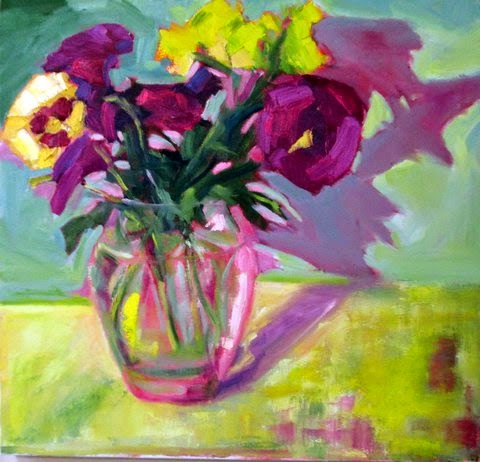Airhead: Plein Air Series #4
Capturing Air on a Flat Surface
-Letters to a Young Poet If you trust in Nature, in the small Things that hardly anyone sees and that can so suddenly become huge, immeasurable; if you have this love for what is humble and try very simply, as someone who serves, to win the confidence of what seems poor, then everything will become easier for you.
(Rainer Maria Rilke)
I went for a run on the beach at low tide this morning and the sky was amazing. All types of clouds were layered in the sky, cumulus low and stratus above, and little wispy bits here and there. I thought it was the perfect day to do small studies of the clouds and sky and I was back within an hour or so with my oil paints. Clear skies had appeared and all the clouds had disappeared. Foiled again!
I usually paint the sky thinly and the clouds a bit thicker and just try to observe and paint whatever I see. Relationship of the sky to the ground and the landscape elements in terms of color and values is my usual approach.

Autumn Beach • available at Isalos Gallery

But lately, I have been thinking that I might study a little bit about the clouds so it might be easier to get them to "float" when that seems important. It works with figure drawing to know the anatomy of humans in order make the drawing process easier and more accurate: why not use the same approach with clouds? (Really. This just occurred to me recently! I have been painting clouds since 1980 or so...go figure!)
I have been reading John Carson's "Guide to Landscape Painting" first published in 1929, revised in 1953 and recommended as a classic for oil painters if you are interested a perceptual approach to the landscape. (Recommended to me by Janet Manyan, by the way.) From the section on clouds:
"I think the sky stimulates the imagination and our aesthetic sensibility more then any other out-of-door element. If we do not feel it when painting, it is lost. In relation to a prevailing outdoor mood or effect, a certain consistency of character is the prime quality of the sky-it makes the mood. This consistency reaches into the design of each separate cloud, and is repeated in the whole, on a larger scale. There is a consistency of color relation, since the colors are visibly steeped in the quality of the prevailing light. All are born of the sky." John Carlson
That makes sense to me to view the sky as the key to the structure of the landscape. I believe most painters do that intuitively, but holding that idea in the analytical part of the mind seems like a useful thing.
In the above painting "Grey Skies" I remember that the sky was very dark and heavy and seemed to press down on the island. I think the sky was changing quickly that day, but the effect of heaviness was there for long enough for me to work with it.
Grey Skies • private collection
 |
| Clouds Over Little • private collection |
You can find the "Carlson's Guide to Landscape Painting" the 1973 Dover reprints edition here. The paintings in the book are all in black and white, but don't let that stop you. There are many nuggets of wisdom in the text.
Everyone have a safe and happy Memorial Weekend holiday!



Comments
Post a Comment